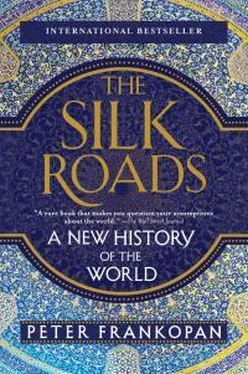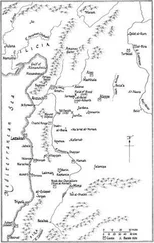In the 330s, rumour spread that Constantine was preparing an attack on Persia, exploiting an opening presented by a disaffected brother of the Shah who had sought sanctuary at the Roman imperial court. Persian nerves must have jangled when a letter was received from Constantine announcing that he was delighted to have learnt that “the finest provinces of Persia are filled with those men on whose behalf alone I am at present speaking; I mean the Christians.” He had a specific message for the Persian ruler Shāpūr II: “I commend these persons to you for your protection…cherish them with your customary humanity and kindness; for by this proof of faith you will secure an immeasurable benefit both to yourself and us.”66 This might have been meant as gentle advice, but it sounded like a threat: not long beforehand, Rome had rolled its eastern frontier deep into Persian territory, and immediately set about a programme of fortification and road-building to secure these gains.67
When the ruler of Georgia, another Caucasian kingdom of commercial and strategic value, experienced an epiphany that was only marginally less colourful than Constantine’s (the king literally saw the light after being engulfed by darkness while hunting), anxiety turned to panic.68 With Constantine absent on the Danube frontier, Shāpūr II launched a surprise attack into the Caucasus, deposing one of the local rulers and installing his own nominee in his place. Constantine responded immediately and dramatically: he assembled an enormous army and, ordering his bishops to accompany the forthcoming expedition, arranged for a replica to be made of the Tabernacle, the structure used to house the Ark of the Covenant. He then announced that he wished to undertake a punitive attack on Persia and be baptised in the River Jordan.69
The scale of Constantine’s ambition knew no bounds. He minted coins in advance, giving his half-nephew a new royal title: ruler of Persia.70 Excitement spread quickly among Christians in the east, captured in a letter written by Aphrahat, head of an important monastery near Mosul: “Goodness has come to the people of God.” This was the moment that he had been waiting for: Christ’s kingdom on earth was about to be established once and for all. “Be certain,” he concluded, “the beast will be killed at its preordained time.”71
As the Persians prepared to mount fierce resistance, they had a huge stroke of luck: before the expedition could get going, Constantine fell ill and died. Shāpūr II proceeded to unleash hell on the local Christian population in Persia as a reprisal for Constantine’s aggression. Egged on by the Zoroastrian authorities, the Shah “thirsted for the blood of the saints.”72 Martyrs were made by the dozen: one manuscript from Edessa at the start of the fifth century records the execution of no fewer than sixteen bishops as well as fifty priests in this period.73 Christians were now regarded as an advance guard, a fifth column that would open Persia to the Roman Empire in the west. Leading bishops were accused of making the Shah’s “followers and people rebel against [his] Majesty and become slaves of the emperor who shares their faith.”74
This bloodbath was a direct result of the enthusiastic adoption of Christianity in Rome. The persecutions unleashed by the Shah stemmed from the fact that Constantine had elided the promotion of the Roman Empire with that of Christianity. The Emperor’s grand statements may have impressed and inspired men like Aphrahat, but they were immensely challenging for the leadership in Persia. Roman identity had been clear-cut before Constantine’s conversion. But now the Emperor—and his successors—was willing to talk of protecting not only Rome and its citizens, but Christians in general too. It was a convenient ace to play, not least at home where the rhetoric was bound to go down well with bishops and the faithful. For those living beyond the empire’s borders, however, it was potentially disastrous—as Shāpūr’s victims found.
It is ironic, therefore, that while Constantine is famous for being the Emperor who laid the basis for the Christianisation of Europe, it is never noted that there was a price to pay for his embrace of a new faith: it spectacularly compromised Christianity’s future in the east. The question was whether the teachings of Jesus Christ that had taken hold deep in Asia would be able to survive a determined challenge.
3
The Road to a Christian East
In due course, tensions between Rome and Persia abated, and as they did so, attitudes to religion softened. This came about because Rome was forced into retreat so firmly in the fourth century that it found itself fighting for its very life. In a series of campaigns that lasted until Shāpūr II’s death in 379, Persia succeeded in taking key nodes along the trade and communication routes running towards the Mediterranean. Nisibis and Sinagra were recovered, and half of Armenia was annexed. Although this territorial rebalancing helped calm animosities, relations really improved when both Rome and Persia were faced with new challenges: disaster was looming from the steppes.
The world was entering a period of environmental change. In Europe, this was evidenced by rising sea levels and the emergence of malaria in the North Sea region, while in Asia from the start of the fourth century sharply reduced salinity in the Aral Sea, markedly different vegetation on the steppes (evident from high-resolution pollen analyses) and new patterns of glacier advances in the Tian Shan range all show fundamental shifts in global climatic change.1
The results were devastating, attested by a remarkable letter written by a Sogdian trader in the early fourth century and found not far from Dunhuang in western China. The merchant recounted to his fellow traders that food shortages and famine had taken a heavy toll, that such catastrophe had befallen China as to be barely describable. The Emperor had fled from the capital, setting fire to his palace as he left, while the Sogdian merchant communities were gone, wiped out by starvation and death. Do not bother trying to trade there, the author advised: “there is no profit for you to gain from it.” He told of city after city being sacked. The situation was apocalyptic.2
The chaos created the perfect conditions for the mosaic of steppes tribes to consolidate. These peoples inhabited the belts of land linking Mongolia with the plains of central Europe, where control of the best grazing land and of reliable water supply guaranteed considerable political power. One tribe now established themselves as masters on the steppes, crushing all before them. The Sogdian trader referred to the architects of apocalypse in his letter as the xwn . They were the Xiongnu—better known in the west as the Huns.3
Between about 350 and 360 there was a huge wave of migration as tribes were shunted off their lands and driven westwards. This was most likely caused by climate change, which made life on the steppe exceptionally harsh and triggered intense competition for resources. The impact was felt from Bactria in northern Afghanistan right up to the Roman frontier on the Danube, where refugees began to appear in large numbers, begging to be allowed to resettle on imperial territory after being driven off their lands north of the Black Sea by the advancing Huns. The situation quickly became dangerously unstable. A massive Roman army sent to restore order was heavily defeated on the flat plains of Thrace in 378, with the Emperor Valens among the many casualties.4 The defences burst open, and tribe after tribe poured through into the empire’s western provinces, threatening Rome as a result. Previously, the northern lip of the Black Sea and the steppe lands stretching deep into Asia had been regarded as implacably barbarous, filled with fierce warriors and empty of civilisation or resources. It had not crossed Rome’s mind that these regions could act as arteries, just like the routes linking the west with the east through Persia and through Egypt. These very regions were now about to deliver death and destruction into the very heart of Europe.
Читать дальше











